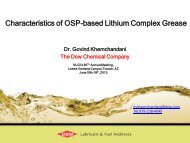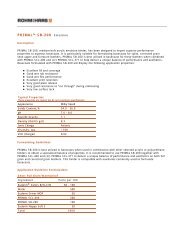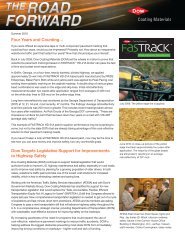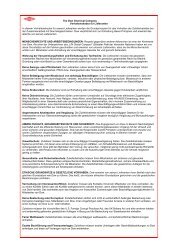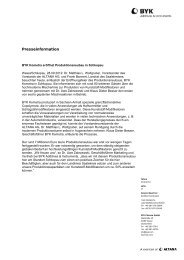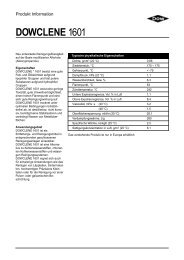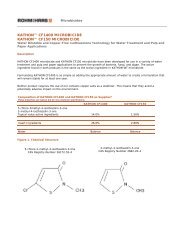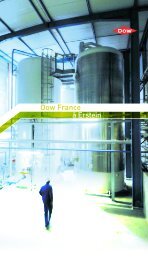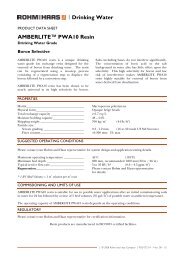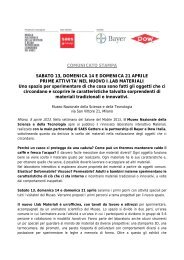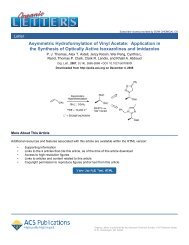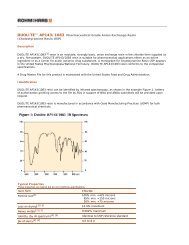Granulation with Dow Cellulosic Polymers II. High Shear Granulation
Granulation with Dow Cellulosic Polymers II. High Shear Granulation
Granulation with Dow Cellulosic Polymers II. High Shear Granulation
Create successful ePaper yourself
Turn your PDF publications into a flip-book with our unique Google optimized e-Paper software.
The remaining figures in this section<br />
are comparisons of METHOCEL<br />
polymers <strong>with</strong> the HPC polymers,<br />
<strong>with</strong> the PVP products, and <strong>with</strong><br />
acacia and pregelatinized starch.<br />
Figure 14 illustrates that using the dry<br />
addition method at 3% results in<br />
virtually no difference between the<br />
two viscosity grades of HPC, both<br />
having 80% drug dissolution in 25<br />
minutes. If the same binders at the<br />
same level utilized the "solution"<br />
method, the HPC-LF gave the same<br />
release profile, while the HPC-EF<br />
gave a slightly longer (t 80% of 31<br />
minutes) profile. Turning to the 6%<br />
level, Figure 15 shows the results of<br />
the solution method, <strong>with</strong> the HPC-EF<br />
and HPC-LF curves indistinguishable<br />
and <strong>with</strong> the time for 80% release at<br />
the USP limit. Using the dry addition<br />
method was not different in terms of<br />
the release profile for HPC-LF, but<br />
once again the EF grade had a<br />
slightly longer release <strong>with</strong> t 80% ≈<br />
32 minutes.<br />
Figures 16 and 17 compare two<br />
METHOCEL products <strong>with</strong><br />
polyvinylpyrrolidone. The dry method<br />
at 3% (Fig. 16) shows that<br />
METHOCEL E5P LV and PVP<br />
(K29-32) are equivalent in dissolution<br />
behavior, <strong>with</strong> the K90 grade just<br />
slightly longer but well <strong>with</strong>in the<br />
specified time period. The solution<br />
addition method gave results<br />
essentially the same. Turning to the<br />
6% level (Fig. 17), METHOCEL A15P<br />
LV and PVP (K29-32) are practically<br />
equivalent, <strong>with</strong> the K90 polymer<br />
again slightly longer, now just <strong>with</strong>in<br />
the specification. Using the dry<br />
method at the 6% binder level<br />
produced dissolution curves where<br />
the METHOCEL A15P LV was just<br />
slightly longer than the PVP (K90)<br />
and which was at the 30 minute limit.<br />
Lastly, a comparison of acacia, a<br />
pregelatinized starch, and<br />
METHOCEL A15P LV is illustrated in<br />
Figure 18. Here it appears that the<br />
derivatized starch is also acting as a<br />
disintegrant, giving the fastest drug<br />
release of all the binders evaluated.<br />
Acacia, despite giving quite soft and<br />
very friable tablets, nevertheless gave<br />
a somewhat unexpectedly long time<br />
for drug dissolution.<br />
Conclusions: Acetaminophen<br />
Model Formulation<br />
<strong>Granulation</strong>s <strong>with</strong> acceptable<br />
densities and particle size<br />
distributions were obtained when 2<br />
acetaminophen formulations having<br />
3% and 6% binder levels were<br />
prepared in a high shear mixergranulator.<br />
There were only minor<br />
differences in these properties<br />
between granulations prepared by<br />
adding the binder as an aqueous<br />
solution or by adding the binder in a<br />
dry state to the active followed by<br />
granulation <strong>with</strong> water. The cellulosic<br />
polymers (METHOCEL and HPC<br />
products) tended to give granulations<br />
<strong>with</strong> a higher proportion of granules<br />
of 20-60 mesh, whereas the PVP<br />
binders produced somewhat more<br />
material in the 80-140 mesh region.<br />
With the given milling conditions,<br />
about 10% fines (



